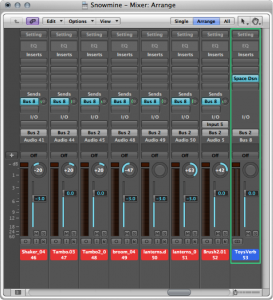[aside]In an attempt to reconcile these two schools of thought on reverberation in the recording studio, some have resorted to installing active acoustic systems in the recording studio. These systems involve placing microphones throughout the room that feed into live digital signal processors that generate thousands of delayed sounds that are then sent into several loudspeakers throughout the room. This creates a natural-sounding artificial reverb that is captured in the recording the same as natural reverb. The advantage here is that you can change the reverb by adjusting the parameters of the DSP for different recording situations. To hear an example of this kind of system in action, see this video from TRI Studios where Bob Weir from the Grateful Dead has installed an active acoustic system in his recording studio.[/aside]
Almost every audio project you do will likely benefit from some reverb processing. In a practical sense, most of the isolation strategies we use when recording sounds will have a side effect of stripping the sound of natural reverberation. So anything recorded in a controlled environment such as a recording studio will probably need some reverb added to make it sound more natural. There are varying opinions on this among audio professionals. Some argue that artificial reverberation processers are sounding quite good now, and since it is impossible to remove natural reverberation from a recording, it makes more sense to capture your recorded audio as dry as possible. This way you’re able to artificially add back whatever reverberation you need in a way that you can control. Others argue that having musicians perform in an acoustically dry and isolated environment will negatively impact the quality of their performance. Think about how much more confident you feel when singing in the shower. All that reverberation from the tiled surfaces in the shower create a natural reverberation that makes your voice sound better to you than normal. That gives you the confidence to sing in a way that you probably don’t in public. So some recording engineers would prefer to have some natural reverberation in the recording room to help the musicians to deliver a better performance. If that natural reverberation is well controlled acoustically you could even end up with a recording that sounds pretty good already and might require minimal additional processing.
Regardless of the amount of reverb you already have in your recording, you will likely still want to add some artificial reverb to the mix. There are three places you can apply the reverb in your signal chain. You can set it up as an insert for a specific channel in a multi-channel mix. In this case the reverb only gets applied to the one specific channel, and the other channels are left unchanged. You have to adjust the wet/dry mix in the reverb processor to create an appropriate balance. This technique can be useful for a special effect you want to put on a specific sound, but using this technique on every channel in a large multi-channel mix costs you a lot in CPU performance because the multiple reverb processors that are running simultaneously. If you have a different reverb setting on each channel you could also have a rather confusing mix since every sound will seem to be in a different acoustic environment. Maybe that’s what you want if you’re creating a dream sequence or something abstract for a play or film, but for a music recording it usually makes more sense to have every instrument sounding like it is in the same room.
The second reverb technique can solve both the problem of CPU performance and varying acoustic signatures. In this case you would set up a mix bus that has a reverb inserted. You would set the reverb processor to 100% wet. This basically becomes the sound of your virtual room. Then you can set up each individual channel in your mix to have a variable aux send that dials in a certain amount of the signal into the reverb bus. In other words, the individual sends decide how much that instrument interacts with your virtual room. The individual channel will deliver the dry sound to the mix and the reverb bus will deliver the wet. The amount of sound that is sent on the variable aux send determines the balance of wet to dry. This strategy allows you to send many different signals into the reverb processor at different levels and therefore have a separate wet/dry balance for each signal, while using only one reverberation processor. The overall wet mix can also be easily adjusted using the fader on the aux reverb bus channel. This technique is illustrated in Figure 7.30.

The third strategy for applying reverberation is to simply apply a single reverb process to an entire mix output. This technique is usually not preferred because you have no control over the reverb balance between the different sounds in the mix. The reason you would use this technique is if you don’t have access to the raw tracks or if you are trying to apply a special reverb effect to a single audio file. In this case just pick a reverb setting and adjust the wet/dry mix until you achieve the sound you are looking for.
The most difficult task in using reverb is to find the right balance. It is very easy to overdo the effect. The sound of reverberation is so intoxicating that you have to constantly fight the urge to apply the effect more dramatically. Before you commit to any reverb effect, listen to it though a few different speakers or headphones and in a few different listening environments. A reverb effect sounds like a good balance in one environment might sound over the top in another. Listen to other mixes of similar music or sound to compare your work with the work of seasoned professionals. Before long you’ll develop a sixth sense for the kind of reverb to apply in a given situation.